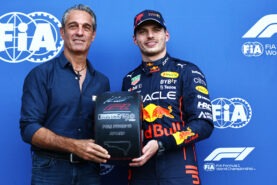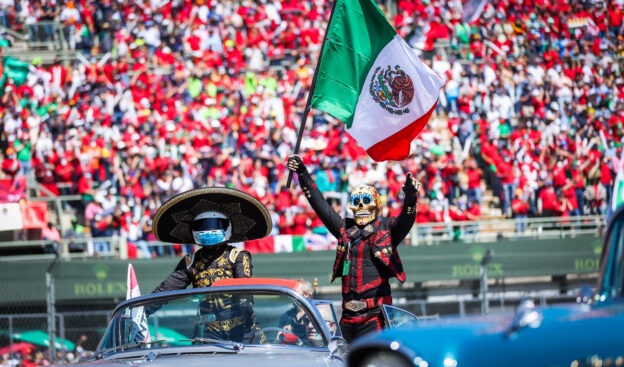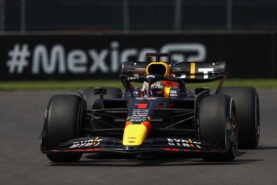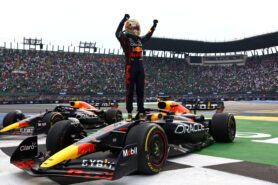Event: Mexico Grand Prix
Track: Autodromo Hermanos Rodriguez

Pole position qualifier Max Verstappen of Red Bull Racing is presented with the Pirelli Pole Position Award by Carlos Slim Domit in parc ferme during qualifying ahead of the 2022 F1 Grand Prix of Mexico (Photo by Mark Thompson/Getty Images)
Warm-up lap starts at: 14:00 Local | 21:00 CET | 20:00 UK | 12:00 LA | 04:00 Tokio
Max Verstappen scored his maiden pole position for the Mexico F1 Grand Prix. He is the 11th different pole sitter of the Mexican GP. It was the 6th pole position of the 2022 F1 season for the Red Bull Racing driver.
Despite a forecast threat of rain during the day, qualifying (which started at 3pm local time) stayed dry with ambient temperatures of 28 degrees centigrade and 48 degrees on track. The chance of rain is lower tomorrow but not insignificant, at around 40% according to Meteo France.
Both Mercedes drivers George Russell and Lewis Hamilton start from P2 and P3. They both have beaten bofh Ferrari drivers Carlos Sainz and Charles Leclerc, who will start from P5 and P7 accordingly.
Valtteri Bottas qualified a very strong P6 in the upgraded Alfa Romeo.
The Pirelli Pole Position Award was presented by Mexican businessman Carlos Slim Domit, the President of America Movil and the well-known Escuderia Telmex racing team, which was founded in 2002 to support Latin American drivers at every stage of their careers. Some of the most famous graduates include Pietro Fittipaldi, Tatiana Calderon, and of course Sergio Perez.
Pole position is on the left side of the track in Mexico City.
F1 Starting Grid 2022 Mexico GP
| Pos | No | Driver | Team | Lap Time | Pole gap |
| 1 | 1 | Max Verstappen | Red Bull | 1:17,775 | |
| 2 | 63 | George Russell | Mercedes | 1:18,079 | +0,304s |
| 3 | 44 | Lewis Hamilton | Mercedes | 1:18,084 | +0,309s |
| 4 | 11 | Sergio Pérez | Red Bull | 1:18,128 | +0,353s |
| 5 | 55 | Carlos Sainz | Ferrari | 1:18,351 | +0,576s |
| 6 | 77 | Valtteri Bottas | Alfa Romeo | 1:18,401 | +0,626s |
| 7 | 16 | Charles Leclerc | Ferrari | 1:18,555 | +0,780s |
| 8 | 4 | Lando Norris | McLaren | 1:18,721 | +0,946s |
| 9 | 14 | Fernando Alonso | Alpine | 1:18,939 | +1,164s |
| 10 | 31 | Esteban Ocon | Alpine | 1:19,010 | +1,235s |
| 11 | 3 | Daniel Ricciardo | McLaren | 1:19,325 | +1,550s |
| 12 | 24 | Zhou Guanyu | Alfa Romeo | 1:19,476 | +1,701s |
| 13 | 22 | Yuki Tsunoda | AlphaTauri | 1:19,589 | +1,814s |
| 14 | 10 | Pierre Gasly | AlphaTauri | 1:19,672 | +1,897s |
| 15 | 47 | Mick Schumacher | Haas | 1:20,419 | +2,644s |
| 16 | 5 | Sebastian Vettel | Aston Martin | 1:20,419 | +2,644s |
| 17 | 23 | Alex Albon | Williams | 1:20,859 | +3,084s |
| 18 | 6 | Nicholas Latifi | Williams | 1:21,167 | +3,392s |
| 19 | 20 | Kevin Magnussen* | Haas | 1:19,833 | +2,058s |
| 20 | 18 | Lance Stroll* | Aston Martin | 1:20,520 | +2,745s |
*Note:
- Lance Stroll, Aston Martin #18 - penalised 3 grid places for causing a collision at the previous round.
- Kevin Magnussen, Haas #20 - penalised 5 grid places for use of additional power unit elements.
Best 2022 Mexico F1 Grand Prix Race Strategy
The 71-lap Mexican Grand Prix (the third-shortest lap of the year) could be a two-stopper or a one-stopper, depending on degradation rates, which can vary from team to team and driver to driver – as well as being influenced by the weather.
A two-stopper is fastest on paper: starting on the soft before two stints on the medium. This strategy is only possible for the 10 drivers who have two sets of mediums still available in their allocation. Soft-medium-soft is an alternative two-stopper.
A medium-hard one-stopper is close to that in terms of overall time while the alternative medium to soft one-stopper is definitely slower.
✅ Check out more posts with related topics:












